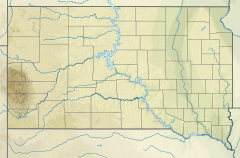Terry Peak
 From Wikipedia the free encyclopedia
From Wikipedia the free encyclopedia
| Terry Peak | |
|---|---|
Location in the United States Location in South Dakota | |
| Location | Lawrence County, South Dakota, U.S. |
| Nearest major city | Lead – 5 miles (8.0 km) Rapid City – 50 miles (80 km) |
| Coordinates | 44°19′44″N 103°50′06″W / 44.329°N 103.835°W |
| Vertical | 1,164 feet (355 m) |
| Top elevation | 7,064 feet (2,153 m) |
| Base elevation | 5,900 feet (1,798 m) |
| Skiable area | 450 acres (1.8 km2) |
| Trails | 30 total |
| Lift system | 4 chairlifts - 3 high-speed quads - 1 triple 1 magic carpet |
| Terrain parks | 1 |
| Website | terrypeak.com |
Terry Peak is a mountain and ski area in the west central United States, in the Black Hills of South Dakota outside of Lead.[1] With an elevation of 7,064 feet (2,153 m) above sea level, it is the most prominent peak in the Northern Black Hills area, and the sixth highest summit in the range; the tallest is Black Elk Peak (formerly Harney Peak) at 7,244 feet (2,208 m).
The mountain was named for Alfred Howe Terry, who had explored the area.[2] It was first used as a ski area in 1936 by the Bald Mountain Ski Club when a rope tow was installed. The first chair lift was installed in 1952 and began operation in 1954. The ski area has since seen many upgrades in chair lifts, trails, and accommodations.
Currently, there are three "high speed" chairlifts (Kussy, Surprise, and Gold Corp Express, (or Blue, Yellow, and Red, respectively), which provide access to most of the runs on the mountain in a matter of minutes, as well as one traditional-speed lift (Stewart, or "Green"), and a Sno-Carpet.
Terry Peak hosted the NCAA Skiing Championships in 1971. Several radio stations have transmitter towers at the summit.
Ski area description[edit]
- 30 runs[3][4]
- 4 lifts (Black lift was removed and replaced by Sno-Carpet)
- Terrain park
- Snowmaking
- Ski and snowboard rental
Climate[edit]
| Climate data for Terry Peak 44.3275 N, 103.8346 W, Elevation: 6,775 ft (2,065 m) (1991–2020 normals) | |||||||||||||
|---|---|---|---|---|---|---|---|---|---|---|---|---|---|
| Month | Jan | Feb | Mar | Apr | May | Jun | Jul | Aug | Sep | Oct | Nov | Dec | Year |
| Mean daily maximum °F (°C) | 31.2 (−0.4) | 31.7 (−0.2) | 39.6 (4.2) | 46.3 (7.9) | 55.7 (13.2) | 66.8 (19.3) | 75.2 (24.0) | 74.3 (23.5) | 65.5 (18.6) | 50.8 (10.4) | 38.7 (3.7) | 31.0 (−0.6) | 50.6 (10.3) |
| Daily mean °F (°C) | 21.3 (−5.9) | 21.2 (−6.0) | 28.6 (−1.9) | 35.1 (1.7) | 44.4 (6.9) | 54.6 (12.6) | 62.3 (16.8) | 61.2 (16.2) | 52.8 (11.6) | 39.8 (4.3) | 29.1 (−1.6) | 21.7 (−5.7) | 39.3 (4.1) |
| Mean daily minimum °F (°C) | 11.4 (−11.4) | 10.7 (−11.8) | 17.6 (−8.0) | 24.0 (−4.4) | 33.1 (0.6) | 42.4 (5.8) | 49.4 (9.7) | 48.2 (9.0) | 40.0 (4.4) | 28.7 (−1.8) | 19.4 (−7.0) | 12.3 (−10.9) | 28.1 (−2.1) |
| Average precipitation inches (mm) | 1.56 (40) | 1.80 (46) | 2.24 (57) | 3.83 (97) | 5.43 (138) | 4.44 (113) | 3.42 (87) | 2.54 (65) | 2.11 (54) | 3.28 (83) | 1.72 (44) | 1.53 (39) | 33.9 (863) |
| Source: PRISM Climate Group[5] | |||||||||||||
See also[edit]
References[edit]
- ^ "The Mountain Info". Terry Peak. Retrieved 2008-03-04.
- ^ U.S. Geological Survey Geographic Names Information System: Terry Peak
- ^ "Terry Peak, South Dakota". GoSki.com. Archived from the original on March 21, 2006. Retrieved 2008-02-27.
- ^ "Statistics". Terry Peak. Retrieved 2008-03-04.
- ^ "PRISM Climate Group, Oregon State University". PRISM Climate Group, Oregon State University. Retrieved October 2, 2023.
To find the table data on the PRISM website, start by clicking Coordinates (under Location); copy Latitude and Longitude figures from top of table; click Zoom to location; click Precipitation, Minimum temp, Mean temp, Maximum temp; click 30-year normals, 1991-2020; click 800m; click Retrieve Time Series button.

